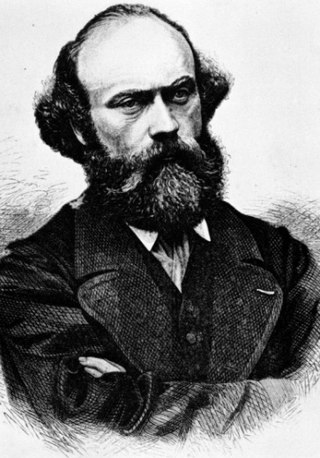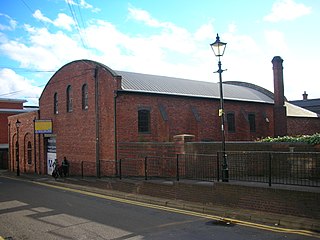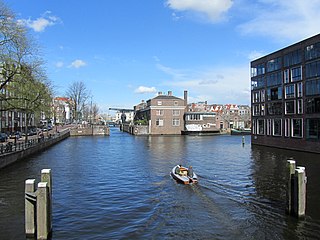The Westergasfabriek is a former gasworks in Amsterdam, the Netherlands, now used as a cultural venue. [1]
Contents

The Westergasfabriek is a former gasworks in Amsterdam, the Netherlands, now used as a cultural venue. [1]

In the 19th century the Imperial Continental Gas Association (ICGA) built four coal gas plants in Amsterdam: the Eastern Gas Factory, the Western Gas Factory, the Northern and the Southern. Westergasfabriek was ready in 1885 and was strategically situated between the Haarlemmer trekvaart, and the first railway line in the Netherlands. [2] In 1885 it was the largest gas extraction plant in the Netherlands.[ citation needed ] The gas was extracted from coal and was used for street lighting. Because of the higher gas prices the City of Amsterdam took over the operation in 1898 and expanded the plant. The plant was perfectly situated between the water and the railway line but gas production was very successful. The big Gasholder was built in 1902. The gas factory produced gas for the city until the late fifties. Amsterdam went over to gas from Hoogovens in IJmuiden, so the production of coal gas from the Factory decreased. In the sixties natural gas was found in Slochteren in the North of the Netherlands. This is why in 1967 the production of gas from the Factory stopped permanently. [2]
After the Western Gas Factory closed the Amsterdam Electricity and Gas Company (GEB) destroyed some of the buildings among them the gas plant itself and the water tower. The other buildings were used for storage and repair and as laboratories and workshops. The remaining buildings were recognised as monuments in 1989. [3] In 1992 the GEB left the buildings and they were taken over by the District Council of Westerpark.
Most of the thirteen buildings on site were designed by architect Isaac Gosschalk in the Dutch Neo Renaissance style, popular in the Netherlands between 1870 and 1915.[ citation needed ] Gosschalk was a famous architect in his time, as famous as Pierre Cuypers and Dolf van Gendt. He was a Jewish architect and he mainly built factories among them the Heineken brewery which is unfortunately completely destroyed and the railway station of Groningen. Gosschalk united the functional nature of the buildings with the beauty of architecture. Symmetry played an important role in his design.[ original research? ] Nineteen of the original buildings remain on the site (not all by Gosschalk) and are designated as national monuments. [4] In the eighties the City of Amsterdam started to think about redevelopment but found out that the site was heavily polluted. In the nineties the District Council of Westerpark took over the responsibilities for the redevelopment. There were four main problems: remediation of the pollution, constructing a new park, finding new use for the derelict buildings and the overall problem: a lack of money.
The gas works were re-opened as the "Culture Park Westergasfabriek" in 2003. [3] Its television studios host programmes like Pauw & Witteman (a former late night talkshow), De Wereld Draait Door (an early evening talk show with Matthijs van Nieuwkerk) and Eva Jinek's Sunday morning talk show. The main grass field of the park allows for six festivals to be organized annually. Thousands of people visit the park and its activities every day.

Utrecht is the fourth-largest city of the Netherlands, as well as the capital and the most populous city of the province of Utrecht. The municipality of Utrecht is located in the eastern part of the Randstad conurbation, in the very centre of mainland Netherlands, and includes Haarzuilens, Vleuten en De Meern. It has a population of 361,699 as of December 2021.

Sittard is a city in the Netherlands, situated in the southernmost province of Limburg.

Gas Works Park is a park located in Seattle, Washington, United States. It is a 19.1-acre (77,000 m2) public park on the site of the former Seattle Gas Light Company gasification plant, located on the north shore of Lake Union at the south end of the Wallingford neighborhood. The park was added to the National Register of Historic Places on January 2, 2013, over a decade after being nominated.

Petrus Josephus Hubertus "Pierre" Cuypers was a Dutch architect. His name is most frequently associated with the Amsterdam Central Station (1881–1889) and the Rijksmuseum (1876–1885), both in Amsterdam. More representative for his oeuvre, however, are numerous churches, of which he designed more than 100. Moreover, he restored many monuments.

The Gas Retort House at 39 Gas Street, Birmingham, England is the last remaining building of Birmingham's first gas works.

Epe is a village in the district of Borken in the state of North Rhine-Westphalia, Germany. It is located on the Dutch border, approx. 10 km east of Enschede. It has been part of the municiplatiy of Gronau since 1975. Epe has a population of about 15,000 and is located on the Dinkel River.

De Bazel is a listed/protected historic building on the west side of the Vijzelstraat in Amsterdam, and stretches from the Herengracht to the Keizersgracht. It stands as an example of Brick Expressionism.


The Westerpark is a public urban park in Amsterdam, Netherlands. The former borough (stadsdeel) of Westerpark is named after the park, as is the current neighborhood.

The Oost-Indisch Huis is an early 17th-century building in the centre of Amsterdam. It was the headquarters of the Amsterdam chamber of the Dutch East India Company. It is a listed Dutch national heritage site (rijksmonument).

De Baarsjes is a district in Amsterdam-West situated west of the city center of Amsterdam, Netherlands. Named after a former hamlet, urban development started in the 1920s. It contains the neighbourhoods Admiralenbuurt, Chassébuurt, Postjesbuurt, and Trompbuurt.

Oostpoort is a neighborhood in the borough Amsterdam-Oost in Amsterdam, Netherlands.

Hotel Die Port van Cleve is a historical 4-star hotel on the Nieuwezijds Voorburgwal in Amsterdam. The hotel is situated in the centre of Amsterdam, immediately north of the Magna Plaza shopping centre, and west of the Royal Palace on the Dam Square.

Westerpark is a neighbourhood of Amsterdam, Netherlands. It is bordered by the Staatsliedenbuurt on the south and the Spaarndammerbuurt on the northeast and Sloterdijk area of Westpoort on the west. It is a non-residential area, containing the park by the same name, the Westergasfabriek, the Sint-Barbara cemetery, and railyards.

The Nieuwe Herengracht is a canal in Centrum district of Amsterdam. The canal is an extension of the Herengracht that runs between the Amstel and the Scharrebiersluis (lock) leading to the Schippersgracht from the Entrepotdok. It is in the Plantage neighborhood in the eastern part of the Grachtengordel.

The Entrepotdok, formerly Nieuwe Rapenburgergracht, is a canal in Amsterdam, and a street and row of former warehouses with the same name along the northeast side of the canal. They were constructed between 1708 and 1829, used for storage, squatted in the 1990s and are now converted into apartments. Entrepotdok is the largest inhabited warehouse complex in Amsterdam. The canal runs between the Kadijksplein and Sarphatistraat, and is parallel to Hoogte Kadijk, Laagte Kadijk, Plantage Doklaan and Natura Artis Magistra zoo.

The Vijzelgracht is a street and former canal in Amsterdam. The Vijzelgracht is adjacent to the Grachtengordel and is an extension of one of the most important city radii for public transport and normal traffic. This through route leads via Vijzelstraat, Rokin, Dam Square and Damrak to Central Station. To the south of Vijzelgracht, the Nieuwe Vijzelstraat connects to Weteringschans.
Awakenings is the collective name of techno parties and festivals that have been organized in the Netherlands since 1997 by events agency Monumental Productions BV. The current Awakenings Summer Festival is one of the biggest techno events in the world. The parties sometimes have a theme that has to do with techno music, such as minimal, Detroit, schranz, Drumcode or Kne'deep.
